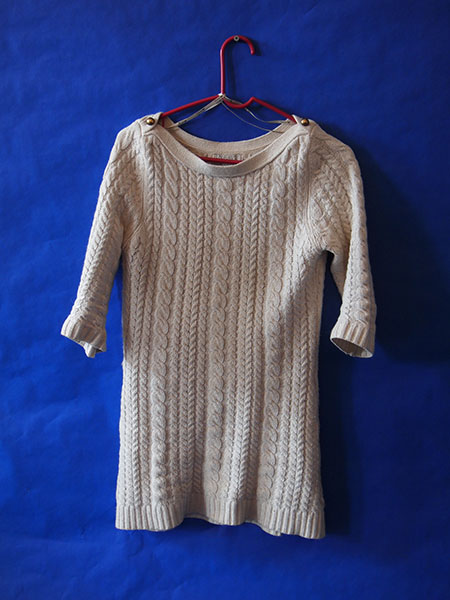![]() body | color | collections | commodity | cube | document | fabric | fetish | gender | glass | home | identity | living | machine | metal | minimal | mobility | narrative | olfactory | organic |
body | color | collections | commodity | cube | document | fabric | fetish | gender | glass | home | identity | living | machine | metal | minimal | mobility | narrative | olfactory | organic |
![]() pain | paper | plastic | plugs | power | protective | rectangular | ritual | round | sound | souvenir | spiritual | style | text-based | time | tool | touch | uniform | value | visual | warm | wood
pain | paper | plastic | plugs | power | protective | rectangular | ritual | round | sound | souvenir | spiritual | style | text-based | time | tool | touch | uniform | value | visual | warm | wood
| Clothing: Cream Colored Long Sweater | |||
Narrative: Forever 21 cream colored long sweater with three-quarter sleeves and gold decorative buttons on each shoulder, small, Made in China The cotton process demands cultivators rip out weeds and grass that may compete with the cotton. Land is plowed under and soil is broken up and formed into rows. Cottonseed is planted. The boll matures in a period that ranges from 55 to 80 days. Ten weeks after flowers first appeared, fibers split the boll apart, and cotton pushes forth. The process includes seeding, picking, ginning, and baling. At this point the cotton plant is defoliated if it is to be machine harvested. Defoliation is often accomplished by spraying the plant with a chemical. At a mill the bale is broken, the fibers are opened by a comb-like device, mixed together, and cleaned. The cleaned cotton fibers are called laps. The laps are fed into a carding machine that separates the fibers. Further cleaning, combing, and sorting readies the fibers for processing into thread. Buttons and labels are made from recycled PET plastic from bottles. Workers sort the bottles by color, separating green ones from clear ones. Then workers visually inspect each piece, and remove any foreign objects. The sorted plastic then moves into a sterilizing bath. The clean containers are dried and crushed into tiny chips. The chips are washed again, and the light-colored batch is bleached. Chips from green bottles stay green, and become yarn that will be dyed a dark color. When the chips are thoroughly dry, they are emptied into a vat and heated, then formed. After nearly 15 years of research first polyester fiber was developed in England known as Terylene in 1941. In 1946 American du Pont de Nemours and Co. purchased right to manufacture polyester in the United States nearly reversing fiber rations in the U.S. in the 1950’s. It’s development and usage in World War II brought the use of synthetic fibers during wartime up 10%. Derived from coal, air, water, and petroleum. Principle ingredient in manufacturing is ethylene (from petroleum). Fibers are formed from a chemical reaction between acid and alcohol. The structure of the molecule created repeats throughout the fiber length. Basic forms of manufacturing are filament, staple, tow, and fiberfill. Does not absorb moisture but does absorb oil; perfect for application of water, soil, fire resistant finishes. Does not stretch out of shape once pre-shrunk, does not get damaged by mildew. I purchased this at Goodwill in Portland Oregon in 2011 on a trip from Manila to Oregon to give a lecture. The clothing I brought from Manila wasn't warm enough for Portland. This sweater traveled with me from Portland to Manila to Brooklyn. |
 |
||
![]()
